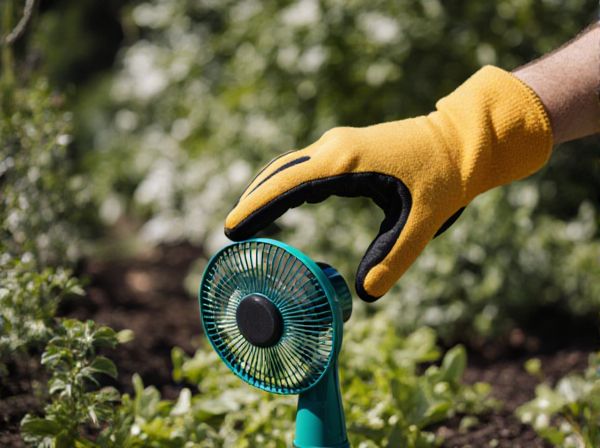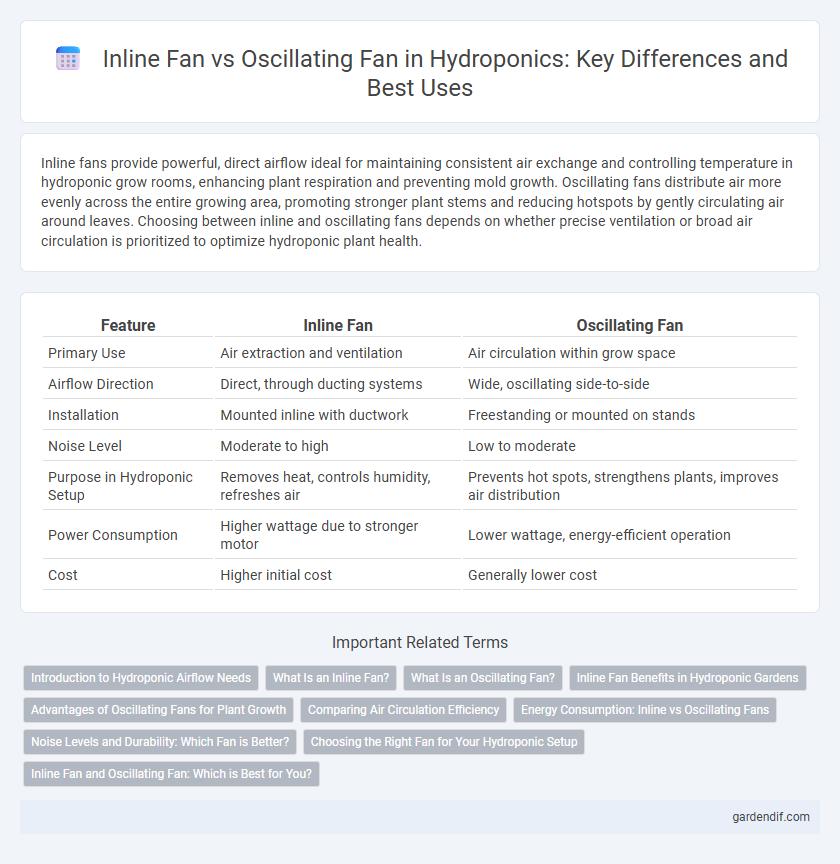
Inline fan vs Oscillating fan Illustration
Inline fans provide powerful, direct airflow ideal for maintaining consistent air exchange and controlling temperature in hydroponic grow rooms, enhancing plant respiration and preventing mold growth. Oscillating fans distribute air more evenly across the entire growing area, promoting stronger plant stems and reducing hotspots by gently circulating air around leaves. Choosing between inline and oscillating fans depends on whether precise ventilation or broad air circulation is prioritized to optimize hydroponic plant health.
Table of Comparison
| Feature | Inline Fan | Oscillating Fan |
|---|---|---|
| Primary Use | Air extraction and ventilation | Air circulation within grow space |
| Airflow Direction | Direct, through ducting systems | Wide, oscillating side-to-side |
| Installation | Mounted inline with ductwork | Freestanding or mounted on stands |
| Noise Level | Moderate to high | Low to moderate |
| Purpose in Hydroponic Setup | Removes heat, controls humidity, refreshes air | Prevents hot spots, strengthens plants, improves air distribution |
| Power Consumption | Higher wattage due to stronger motor | Lower wattage, energy-efficient operation |
| Cost | Higher initial cost | Generally lower cost |
Introduction to Hydroponic Airflow Needs
Hydroponic systems require optimal airflow to regulate temperature, humidity, and carbon dioxide levels for healthy plant growth. Inline fans provide powerful, consistent air exchange ideal for exhausting stale air and maintaining controlled environments in grow tents or rooms. Oscillating fans promote gentle, uniform air circulation around plants, reducing hotspots and strengthening stems by simulating natural wind patterns.
What Is an Inline Fan?
An inline fan is a powerful ventilation device designed to be installed within ductwork, efficiently moving air through hydroponic grow rooms to control temperature, humidity, and odor. Unlike oscillating fans that circulate air within a space, inline fans actively exhaust stale air and introduce fresh air, promoting optimal plant growth conditions. These fans come in various sizes and capacities, measured in cubic feet per minute (CFM), to match the specific airflow requirements of hydroponic systems.
What Is an Oscillating Fan?
An oscillating fan in hydroponic systems is designed to rotate from side to side, promoting even air distribution and improving overall airflow within the grow space. This movement helps prevent hotspots and strengthens plant stems by simulating natural wind patterns. Compared to inline fans, oscillating fans primarily enhance localized air circulation rather than providing direct ventilation or exhaust functions.
Inline Fan Benefits in Hydroponic Gardens
Inline fans provide powerful, consistent airflow essential for maintaining optimal temperature and humidity levels in hydroponic gardens, which promotes healthy plant growth and prevents mold and mildew. Their ability to be connected to ducting allows for precise ventilation control and efficient air exchange, ensuring fresh air circulates throughout the grow space. Unlike oscillating fans, inline fans operate quietly and continuously, making them ideal for enclosed hydroponic systems requiring stable environmental conditions.
Advantages of Oscillating Fans for Plant Growth
Oscillating fans improve plant growth by promoting uniform air circulation, which helps prevent hotspots and reduces the risk of mold and mildew in hydroponic systems. Their gentle, oscillating motion strengthens plant stems by mimicking natural wind, enhancing structural resilience and nutrient uptake. Unlike inline fans that primarily control temperature and humidity, oscillating fans directly influence microclimate stability around plants, boosting photosynthesis efficiency and overall health.
Comparing Air Circulation Efficiency
Inline fans provide superior air circulation efficiency in hydroponic systems by delivering consistent, high-velocity airflow directly through ventilation ducts, ensuring optimal temperature and humidity control. Oscillating fans enhance air distribution by gently moving air across the grow area, preventing hotspots and promoting uniform transpiration among plants. Combining both fan types can maximize airflow dynamics, balancing powerful ventilation with comprehensive air movement for healthier hydroponic crop growth.
Energy Consumption: Inline vs Oscillating Fans
Inline fans typically consume more energy than oscillating fans due to their higher air-moving capacity and continuous operation in hydroponic systems. Oscillating fans use less power by distributing airflow intermittently, making them more energy-efficient for maintaining air circulation in smaller grow spaces. Choosing the right fan depends on balancing airflow requirements with energy costs to optimize hydroponic grow environment efficiency.
Noise Levels and Durability: Which Fan is Better?
Inline fans typically produce higher noise levels compared to oscillating fans due to their powerful motors designed for ventilation efficiency. Oscillating fans generate softer, more dispersed airflow, resulting in quieter operation suited for delicate indoor hydroponic setups. Durability-wise, inline fans often feature robust metal housings and components engineered for continuous use, while oscillating fans may have more plastic parts, affecting their longevity under constant operation.
Choosing the Right Fan for Your Hydroponic Setup
Inline fans provide powerful ventilation and efficient air exchange, making them ideal for controlling humidity and temperature in enclosed hydroponic grow rooms. Oscillating fans improve air circulation within the growing area, reducing the risk of mold and strengthening plant stems by simulating natural wind flow. Selecting the right fan depends on the size of the hydroponic system, ventilation needs, and environmental control requirements.
Inline Fan and Oscillating Fan: Which is Best for You?
Inline fans provide powerful ventilation by actively moving air through duct systems, ideal for controlling temperature and humidity in hydroponic grow rooms. Oscillating fans improve air circulation within the grow space, preventing hot spots and promoting stronger plant stems through consistent airflow. Choosing between inline and oscillating fans depends on your hydroponic setup size and ventilation needs, with inline fans excelling in exhaust and intake efficiency, while oscillating fans ensure even air distribution.
Inline fan vs Oscillating fan Infographic

 gardendif.com
gardendif.com